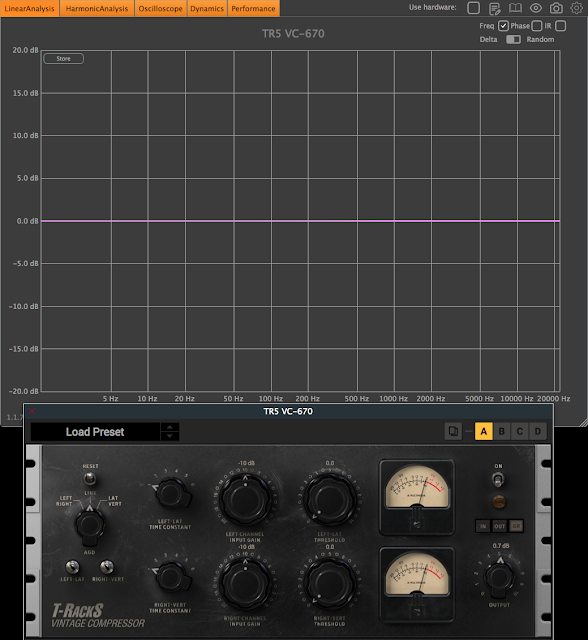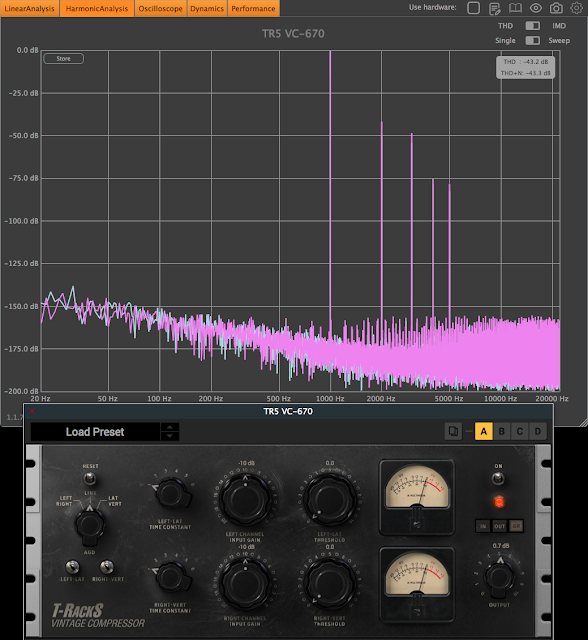PluginDoctor is an Amazing Tool for Mixing with Plugins
Have you ever messed around with PluginDoctor? I am amazed at what I'm learning about my plug-ins with the hours I've spent noodling with this cool tool.
 , a Fairchild 670 emulation that I use often. Right away I was able to confirm that IK Multimedia's "Bypass" toggle really is true bypass. Notice the linear frequency response.
, a Fairchild 670 emulation that I use often. Right away I was able to confirm that IK Multimedia's "Bypass" toggle really is true bypass. Notice the linear frequency response.
Let's see what happens when I engage the plugin...
That low and high frequency roll-off took me by surprise. By default, the plugin loads with the output knob set at 2 dB. With low and high frequencies rolled-off and a 2 dB gain boost, we can see that this plugin will evenly lift the frequencies between 100 Hz and 5,000 Hz. For this example, I wanted the midrange back to unity gain so I dialed the output back to 0.7 dB.
Here is the harmonics analysis with the plugin in "Bypass."...
PluginDoctor is only sending a pure 1 kHz tone. We can see noise down at -175 dB. That's probably not something to be concerned about since it's way below the noise floor of 24-bit resolution recording (which is -144 dB). By the way, this is what every plugin shows in bypass, unless the bypass is not a true bypass.
Now let's look at the coloration that happens when I engage the plugin...
If you found this interesting and want to know more about PluginDoctor, I highly recommend this more detailed review of PluginDoctor by Soundbytes. I didn't even show you the Oscilloscope or the Dynamics and Performance sections. Or just get the app and try it for yourself! Happy mixing!
What is PluginDoctor?
PluginDoctor is not a plugin but a standalone app that can load your plugins for evaluation of frequency response, coloration, noise, dynamics, and performance. It crashed for me a few times at first, but then it settled down. Because it uses a lot of CPU and makes my laptop fan kick in, I wouldn't recommend running it alongside of your DAW session. I would, however, recommend using it on its own. I'm getting a better understanding of my mixing tools, and as of this writing PluginDoctor is $19.What can you do with PluginDoctor?
At the top of this post is a simple example using IK Multimedia TRacks 5 VC-670Let's see what happens when I engage the plugin...
That low and high frequency roll-off took me by surprise. By default, the plugin loads with the output knob set at 2 dB. With low and high frequencies rolled-off and a 2 dB gain boost, we can see that this plugin will evenly lift the frequencies between 100 Hz and 5,000 Hz. For this example, I wanted the midrange back to unity gain so I dialed the output back to 0.7 dB.
Here is the harmonics analysis with the plugin in "Bypass."...
PluginDoctor is only sending a pure 1 kHz tone. We can see noise down at -175 dB. That's probably not something to be concerned about since it's way below the noise floor of 24-bit resolution recording (which is -144 dB). By the way, this is what every plugin shows in bypass, unless the bypass is not a true bypass.
Now let's look at the coloration that happens when I engage the plugin...
We can see the harmonics and noise that are generated. I see a few harmonics added to the pure sine wave. Noise is also added, and the noise floor is louder towards the lower end with more dynamic differences on the upper end frequencies. The noise floor is still way down at -150 dB so I'm not sure if it's even audible at this level.
Things get more intense when we add some compression by turning down the threshold just a little...
With a threshold of just -1.5 dB we can see the harmonics increased and there's quite a bit of aliasing. I often hold back on the 670 compression. It's very colorful!
Here's what you get when you turn the threshold down to -3 dB...
Things get more intense when we add some compression by turning down the threshold just a little...
With a threshold of just -1.5 dB we can see the harmonics increased and there's quite a bit of aliasing. I often hold back on the 670 compression. It's very colorful!
Here's what you get when you turn the threshold down to -3 dB...
If you found this interesting and want to know more about PluginDoctor, I highly recommend this more detailed review of PluginDoctor by Soundbytes. I didn't even show you the Oscilloscope or the Dynamics and Performance sections. Or just get the app and try it for yourself! Happy mixing!






Great article, thanks. It shows why I like the T-Racks 670 on my guitar bus. Guitars usually love harmonic enrichment aka dirt. :)
ReplyDelete